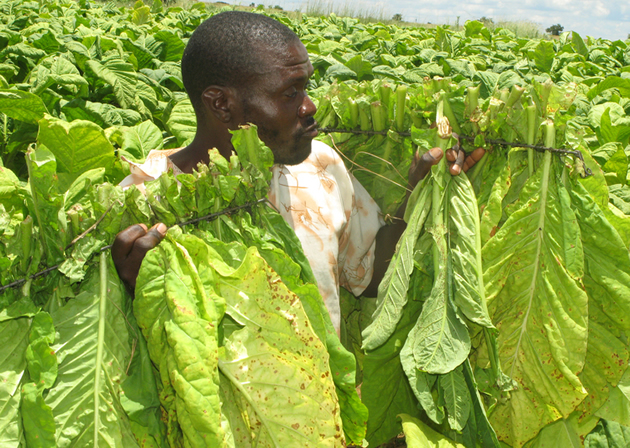
The Sunday Mail

 THERE is a lot of high-flying and back-patting particularly in the tobacco industry. The feat achieved in the past 14 years – of which 10 years were poisoned by a withering onslaught from the United States of America and the European Union bloc – is nothing short of phenomenal.
THERE is a lot of high-flying and back-patting particularly in the tobacco industry. The feat achieved in the past 14 years – of which 10 years were poisoned by a withering onslaught from the United States of America and the European Union bloc – is nothing short of phenomenal.
Statistics captured last week were very telling: The 106 439-strong legion of registered growers have managed to breach the 200 million kilogramme mark, 37 kilogrammes shy of the record crop that was recorded in 2000.
Purse-busting cheques have also naturally followed.
By the end of last week tobacco growers had pocketed more than US$600 million, a figure that is equivalent to the money Zimbabwe managed to generate from South African-bound exports in the first three months of the year.
South Africa is the country’s largest trade partner.
Buoyed by such rich pickings, local farmers are understandably dreaming big, but so too are groups that intend to reduce the consumption of tobacco and tobacco-related products.
Between October 13 and October 18 this year, Parties to the World Health Organisation (WHO) Framework Convention on Tobacco Control (FCTC) – the first treaty signed under the auspices of WHO to curb the health effects of tobacco – will convene in Moscow, Russia, for the sixth Conference of Parties (COP).
And as is dreaded by the tobacco sector, growers included, the provisional agenda for the COP indicates that there will be further discussions on price and tax measures to reduce the demand for tobacco, including deliberations on the “regulation of the contents of tobacco products” and on “economically sustainable alternatives to tobacco growing”.
In essence, the game plan is to make tobacco less appealing to the consumer and less marketable as well.
Sadly, two arms of Government – the Ministry of Health and the Ministry of Agriculture – are conflicted on the course to purse.
On the one hand, Government sincerely wants to eradicate “lifestyle” or non-communicable diseases such as bronchitis, emphysema, heart disease and cancer that are directly related to the smoking, but, on the other hand, authorities feel compelled to defend a sector that is directly and indirectly impacting the lives of more than six million Zimbabweans.
Over the years, local interventions have been made to try and wean off smokers from tobacco addiction as well as control the marketing of tobacco-related products.
In 2002 Government promulgated Statutory Instrument 264 which makes it mandatory for retailers to sell or distribute tobacco products in specially inscribed packs or containers.
The legal instrument further outlines the rules and regulations guiding the sale of cigarettes, the packaging required, including the attendant health warnings.
Also, the 2013 National Budget also raised excise duty on cigarettes by 50 percent from US$10 per 1 000 sticks to US$15. But WHO through FCTC expects further interventions.
Experts believe that a 10 percent increase in cigarette prices reduces demand by 2 to 6 percent in low- and middle-income countries.
WHO recommends that at least 70 percent of the retail price of tobacco products comes through excise taxes, and, currently, only five nations have achieved this best-practice standard.
Clearly, Government cannot be reasonably expected to take further actions that are likely to dent the gains recorded in the tobacco sector thus far.
Tobacco has an immense impact on the livelihoods of many people in Zimbabwe and the region.
More than 82 percent of the 106 000 registered growers are mainly small-scale growers occupying plots of between one and two hectares.
There are also 17 merchants, four licensed auction floors, three green leaf thrashing plants and seven cigarette manufacturers that subsist off activity in the sector.
All these provide employment to multitudes of locals.
The sector has naturally been fretting about Articles 9, 10, 17 and 18 of the FCTC.
Articles 9 and 10 deal with governing the contents of tobacco products and tobacco product disclosures respectively, while Articles 17 and 18 deal with the provision of support for economically viable alternatives and the protection of the environment and health of persons correspondingly.
Draft guidelines on Articles 9 and 10 recommend the ban on the use of ingredients in tobacco products, a development that will ultimately prevent the trade of Burley and Oriental tobacco, which are used in traditional blended products.
Most of the proposals have a direct bearing on local tobacco growers, the bulk of which heavily depend on wood for curing their tobacco.
In addition, the aggregate impact of all these measures on market demand is highly likely to affect the well-being of the industry.
Since Zimbabwe recently ratified the protocol on tobacco control, it is now in good stead to also be involved in conversations and lobby efforts to determine the outcome of the Convention.
Much effort needs to be invested in order to ensure that a win-win outcome can be achieved because as it stands it seems the anti-tobacco lobby is gathering momentum.
Some of the world’s richest personalities such as Bill Gates and Michael Bloomberg have invested more than US$600 million over the past couple of years towards efforts to ban the golden leaf.
So the stakes are definitely high and producing countries, as is being advocated by the International Tobacco Growers’ Association (ITGA), which convened a regional meeting in Harare last week, need to ally to ensure a rational outcome from such key international meetings.
Feedback: [email protected]






